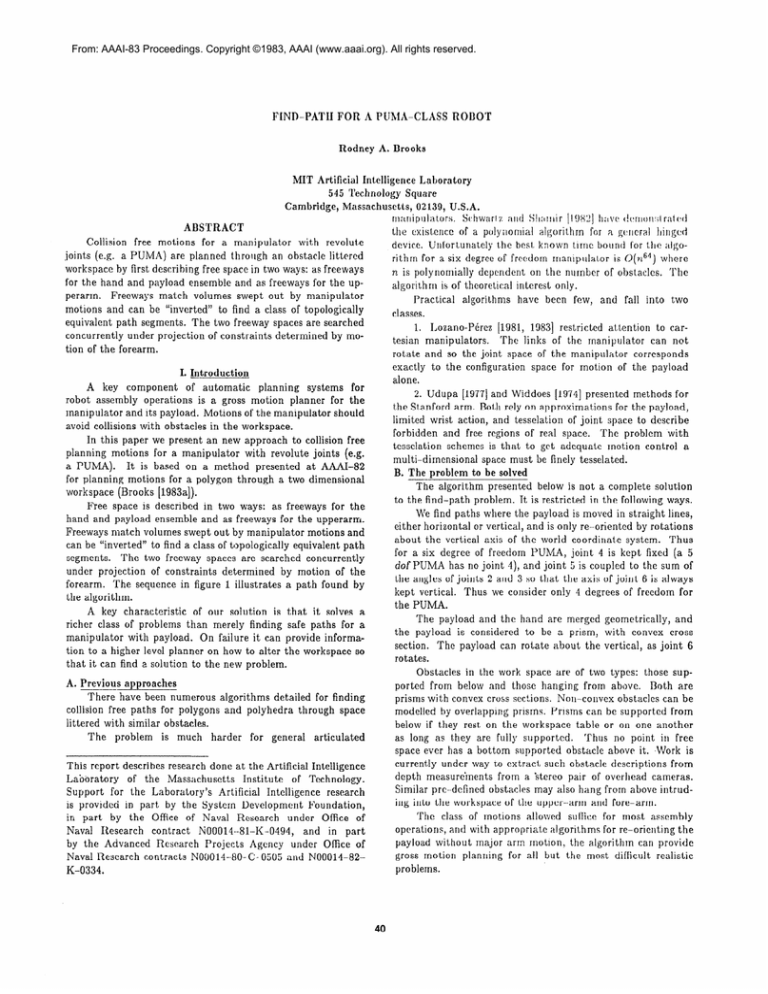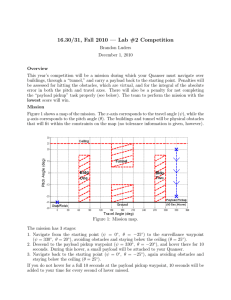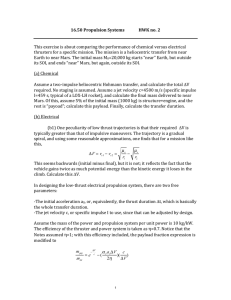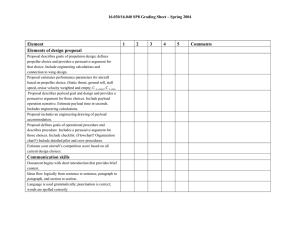
From: AAAI-83 Proceedings. Copyright ©1983, AAAI (www.aaai.org). All rights reserved.
FIND-PATH
FOR
A PLJM&CLASS
Rodney
ROtIOT
A. Brooks
MIT Artificial
Intelligence
Laboratory
545 Technology
Square
Cambridge,
Massachusetts,
02139, U.S.A.
Dl;lrlipUliItbrS. Schwarl 7. arltl S!l:lrIlir [198Z] h;r\‘r c!c,rrlon’;l rnt(sd
ABSTRACT
the cxist,ence of a polyilornial
algorithm
for a gc>rlcral hinged
Collision
free motions
for a manipulator
with revolut,e
device. Unfortunately
the best known time bound for the algojoints (e.g. a PUMA) are planned through
an obstacle littered
rithm for a six degree of frcctlorn mariipulalor
is O(n6’) where
workspace
by first describing
free space in two ways: as freeways
n is polynomially
dependent
on the number of obstacles.
The
for the hand and payload ensemble and as freeways for the upalgorithm
is of theoretical
interest only.
Freeways
match volumes
swept out by manipulator
perarm.
Practical
algorithms
have been few, and fall into two
motions and can be “inverted”
to find a class of topologically
equivalent
path segments.
The two freeway spaces are searched
by moconcurrently
under projection
of constrai nts determined
tion of the forearm
I. Z_ntroduction
A
key component
of automatic
planning
systems
for
robot assembly
operations
is a gross motion
planner
for the
manipulator
and its payload.
Motions of the manipulator
should
avoid collisions with obstacles in the workspace.
In this paper we present an new approach
to collision free
planning
motions
for a manipulator
with revolute joints (e.g.
a PUMA).
It is based on a method
presented
at AAAI-82
for planning
motions for a polygon through
a two dimensional
workspace
(Brooks (1983a)).
Free space is described
in two ways: as freeways
for the
hand and payload
ensemble and as freeways for the upperarm.
Freeways mat,ch volumes swept out by manipulator
motions and
can be “inverted”
to find a class of topologically
equivalent path
segments.
The two freeway spaces are searched
concurrently
under projection
of constraints
determined
by motion of the
forearm.
The sequence in figure 1 illustrates
a path found by
the algorithm.
A key characteristic
of our solution
is that it solves a
richer class of problems
than merely finding safe paths for a
manipulator
with payload.
On failure it can provide information to a higher level planner on how to alter the workspace
so
that it can find a solution to the new problem.
detailed for finding
edra through
space
The
problem
is
much
harder
for
general
articulated
This report describes research done at the Artificial Intelligence
Laboratory
of the Massachusetts
Institute
of Technology.
Support
for the Laboratory’s
Artificial
Intelligence
research
is provided
in part by the System Development
Foundation,
in part
by the Office of Naval Research
under
Office of
Naval Research
contract
N00014--81-K-0494,
and in part
by the Advanced
Research
Projects
Agcrq
under OlTice of
Naval Research
contracts
NOOO14--80-C- 0505 and N00014-82K-0334.
classes.
1. Lozano-Perez
[1981, 19831 restricted
attention
to cartesian manipulators.
The links of the manipulator
can not
rotate and so the joint space of the manipulator
corresponds
exactly
to the configuration
space for rnotion of the payload
alone.
2. Udupa [1977] and Widdoes [1974] presented
methods for
the Stanford arm. Both rely on approximations
for the payload,
limited wrist action, and tesselation
of joint space to describe
forbidden
and free regions of real space.
The problem
with
tesselation
schemes is that to get adequate
motion control
a
multi-dimensional
space must be finely tesselated.
B. The problem to be solved
The algorithm
presented
below is not a complete
solution
to the find-path
problem.
It is restricted
in the following ways.
We find paths where the payload is moved in straight lines,
either horizontal
or vertical, and is only re-oriented
by rotations
about the vertical axis of the world coordinate
system.
Thus
for a six degree of freedom PUMA, joint 4 is kept fixed (a 5
dof PUMA has no joint a), and joint I, is coupled to the sum of
the angles of joints 2 and 3 so that the axis of joint 6 is always
kept vertical.
Thus we consider only 4 degrees of freedom for
the PUMA.
The payload and the hand are merged geometrically,
and
the payload
is considered
to be a prism, with convex cross
The payload can rotate about the vertical,
as joint 6
section.
rotates.
Obstacles
in the work space are of two types: those supBoth are
ported from below and those hanging
from above.
prisms with convex cross sec?,ions. Non-convex
obstacles can be
modelled by overlapping
prisms. Prisms can be supported
from
below if they rest on the workspace
table or on one another
Thus no point in free
as long as they are fully supported.
space ever has a bottom supported
obstacle above it. ,Work is
currently
under way to extract
such obstacle descriptions
from
depth measureinents
from a ‘stereo pair of overhead
cameras.
Similar prc--defined
obstacltss may also hang from above intruding into the workspace
of the upper--arm
and fore-arm.
The class of motions
allowed
sul‘ficc for most assembly
operations,
and with appropriate
algorithms
for re-orienting
the
payload without
major arm motion, the algorithm
can provide
gross motion
planning
for all but the most diflicult
realistic
problems.
Figure 2A. The PUMA has six revolute joints.
It can be decomposed
into three components:
the upperarm,
the forearm, and the combined
wrist, hand and payload.
Figure
2B. A freeway
is an elongated
describes
a path between obstacles.
piece
of free
space
which
Figure 2C. The definition
of R(E), the radius function
of an object,
(a). Part (b) s h ows the geometric
construction
of R(E) = dz cos(S R in polar coordinates.
qz), (locally).
Part (c) shows function
Figure
1. A path found by the algorithm.
Part (a) is the initial
configuration.
Part (b) is a plan view (rotated
5). Part (c) is a plan
view of the payload
path. The remaining
images (top to bottom,
left
to right) show the path.
horizontal
of figu re 1 has three different
Tgure 2D. The workspace
cross sections.
Here we see the spines of freeways for the payload
in
the lowest cross section in which they are valid.
41
horizontally.
The class of possible motions of the arm can not be easily
characterized
as translational
constraints
as was the case with
the payload.
It is better to describe
freeways
for it in the
configuration
space (Lozano-Perez
[1981, 19831) of 4 and Q.
Furthermore
the upper-arm
can not change orientation
in &-cr
space and its shape is fixed (in contrast
to the payload which
changes shape as things are picked up and put, down). over all
time.
Therefore
we can compile in special knowledge
of that
shape (in contrast
to the general R(O) function
used for the
payload).
II. Payload
Space
_-.-Figure 2R is a side vi& if. a PUMA robot grasping an object. During gross motion we treat the mrist, hand and payload
as a single object. It can translate
through space (joints 1, 2 and
3 provide the motion wh11e joint 5 compensates
for orientation
changes to keep the wrist stem axis vertical) and rotate about
the vertical axis (joint 6).
The first step of the find-path
algorithm
is to find a prism
(the payload prism) which contains the wrist, hand and payload,
with axis of extension
parallel to the wrist stem. This can be
simply done by taking the convex hull of the projection
of these
parts into the horizontal
plane then sweeping it up from the
base of the payload object through
the wrist.
A. Constraints ______
in a-space
Consider
figure 3A: a cross section of the
an obstacle for a particular
fixed 4. All lengths
are labelled with positive values.
The presence
puts constraints
on the valid range of angles of
the presence of the obstacle implies that
Since obstacles
must be supported
completely
and motions
will only be horizontal
or vertical it follows that it suffices to
find a path for the bottom cross section of the payload prism.
A. The problem
in two dimensions
Brooks [1983a] demonstrated;
new approach
for the problem of moving a two dimensional
polygon through
a plane littered with obstacle polygons.
It was based on two ideas.
Q > t + q = atan(z,
It remains
(1) Free space can be represented
as overlapping
“freeways”.
A
freeway is a channel through free space with a straight axis and
with a left and right radius at each point. Figure 2B illustrates.
to determine
upper-arm
and
in the diagram
of the obstacle
joint 2. Clearly
m) + rl.
7. Let
r = d/m2 + x2.
Then
(2) The moving object can be characterized
by its radius function, defined in figure 2C. The radius function characterizes
the
left (i.e. R(B + 3)) and right (i.e. R(6 - 5)) radii of the object
as it is swept along in some direction
6.
x = r cos 7 and so
rsinq
= bl -alrcosrl,
whence
The key point is that radius functions
and sums of radius
functions
can be easily inverted.
Thus given a freeway and the
radius function of a moving object it is simple to determine
the
legai range of orientations
wllich lrad to no collisions when the
object is swept down the freeway.
In the implementation
described in this paper freeways are
currently
restricted
to having constant
left and right radii along
their length.
The first part of figure 2D shows the “spines” of
freeways found at table top level of the scene in figure 1.
B. Adding
-------~ vertical variations
There are at most as many different horizontal
cross sections through
the workspace
as there are obstacles.
We can
apply the algorithms
of Brooks [1983a] to each different cross
section and derive a set of freeways valid over some horizontal
slice of the workspace.
Figure 3A. A cross section of the upperarm and its interaction
with
a prism obstacle.
Equation (3) is the constraint
derived from this
figure.
Since obstacles
must always be completely
supported
by
others below it is true that any freeway valid at some height
higher cross
ho is also valid for all h > ho. Thus successively
sections will inherit freeways from below. Figure 21> shows a
series of cross sections through the example workspace
of figure
1. These are plan views, rotated 4 from the original scene. Each
cross section includes the spines of all freeways which are valid
for the first time at that height. Their validity extends vertically
upwards through
the remainder
of the workspace.
(Recall that
we assume that the hanging obstacles do not protrude
into the
payload workspace.)
III. -IJpperarm
Space
The upper-arm
(see figure 2A) is large and can easily collide
Its
with any significantly
sized obstacles
in the workspace.
motion is both controlled
and constrained
by joints 1 and 2.
Let the state of these joints be described
by variables
q5 and
If cr = 0 then the upper-arm
is sticking out
Q: respectively.
Figure 313. A plan view of the interaction
top edge of an obstacle prism.
42
of the ui)perarrn
and the
and so
7 = arcsin
rh>Ti
-
atanh
on the table are represented.
The small obstacle
can not be
reached by the upper-arm
and so does not place any constraints
on &-cr space.
11,
whence
tv > atan(z,
m) - atan(al,
1) + arcsin
J&q&c
(a12 + 1)’
(3)
Due to the restrictions
we have placed on our models of
objects in the world we can conclude
that vertices such as v
in figure 3A must be points on the top edges of prisms.
The
problem to be solved is to determine
how m and z vary with
changing
4.
The inequality,
with appropriate
sign changes,
is valid for
obstacles intruding
into the workspace
from above the arm also.
We can ignore collisions with the end of the upper arm as
such a collision would also result in a collision for the fore-arm.
We find it more convenient
to catch such collisions under our
fore-arm
analysis.
B. Constraints in &space
Refer again to figure 3A and consider
a varying
4 and
the interaction
of the upper-arm
with a prism edge.
Clearly
z remains constant,
but m can vary.
Refer to figure 3B. Suppose the edge has a normal with
orientation
vg and further that the edge has distance D from
the origin.
Let d be the displacement
of the upper-arm
from
the axis of joint 1 of the arm. Then
m=
D -
d sin($ cos(q5 -
v())
The analysis a.bove has been done for an upper-arm
that
is paper thin. An upper-arm
with real thickness
has infinitely
many such cross sections,
all of which can contribute
constraints on cr. Observe however that as the upper-arm
is rotated
downwards
towards a horizontal
edge then the arm will hit with
one of its edges first (except when 4 = ~0, when the lower surface strikes simultaneously
across a line segment).
Thus we need
consider the constraints
a.rising only from the two extreme cross
sections (note that they have different d’s so the 4’s which must
be considered
are different).
C. Freeways
in 4-a
space
We have successfully
reduced the collision avoidance
problem for the upper-arm
in real space to one of an path finding
problem
for a point in a space populated
with rectangular
obstacles aligned with the axes of the space. Furthermore,
since
we allow only prismatic
obstacles
stacked on each other on the
table, or hanging
from above, there can be no “free-floating”
obstacles in #-a, space.
We can easily compute
“freeways”
in this space and their
spines are illustrated
in the second part of figure 3C. Searching
these freeways for a path is also trivial and the third part of 3C
illustrates
the connected
chain of +-(r freeways which must be
negotiated
to solve the problem shown in figure 1.
IV. Projecting
vg)
-
Direct analysis of the effects on Q of this formulation
for m is
difficult. However we can observe geometrically
that m depends
rather directly
on the distance
from 0 to I’. The minimum
possible OP is n (so long as the upper -arm intersects
the edge
for $J = va) or the value at one of the end points for the edge.
Similarly the maximum
can only occur at the end of an edge.
When OP has length D then
m=diFTF.
Thus by examining
at most three values for 4 we can determine
maximum
and minimum values for m.
Now consider
the three terms on the right of inequality
(3). The second term is constant
with respect to 4. The third
term increases as m decreases,
and thus has its maximum
over
of the first term
an edge for the minimum
m. The behavior
depends on the sign of z. For positive z (i.e. for obstacles higher
then the axis of joint 2) the second term has maximum
value
for minimum
m, whilst
.for negative
z the maximum
occurs at
produce
a
maximum
m. Thus for a given z we can quickly
conservative
bound on Q over the range of 4 where the upperarm might intersect
the edge. Detailed analysis
shows that for
most obstacles this conservative
bound is very good.
For a prismatic
obstacle
in the workspace
we take each
top edge and determine
conservative
a bounds over a 4 range
The
for each edge which “faces” the base of the manipulator.
resulting
@-CY boxes are then merged and bounded
by single
&-cr box. For large obstacles
with many edges it is better to
approximate
by a series of adjacent
+-a boxes.
The Fig 3C
series shows the &-a boxes generated
by the scene in Figure 1.
Notice that only the overhead obstacle and the larger obstacle
Constraints
Our find-path
algorithm
is based on propagating
constraints
on motion of the upper-arm,
fore-arm
and payload
through
the searches for paths for these three physical
components.
In this section we examine the propagation
of constraints
on
the upper-arm
to become constraints
on the payload.
Consider
the plan view of figure 4A, and the problem
of moving the
payload along a horizontal
path segment.
The maximal
value for CYmust occur when m is minimal
(note that this m and the d from the diagram are different (but
similar in concept) from those of section III). That will occur
when
m=diFTP
i.e. at
40 = vo + atan(d,
m).
Thus the maximal
value for a occurs at $0 if that is in the
range of the motion segment or at one of the extremes
of the
segment.
Similar reasoning
shows that the minimal value for
(x must occur at one of the segment extremes.
Notice that the
points of maxima and minima do not depend on the height of
the segment of motion. The values of those maxima and minima
will however.
Consider a fixed point (z, y) in the table plane and how the
value of a! varies as the payload
is lifted vertically
above that
point. Refer to the plan and side views of figure 4B. The side
view is a cross section through
the arm parallel to the upper
and fore arms. Notice first that
r = dx2
Clearly
the maximum
+ y2 -
achievable
Qm = arccos
d2.
CYis
7--
12
11
Thus for an interval
[or, ~21 the minimum
and maximum
heights which can be achieved by the end of the fore-arm
are
given by
w + l1 sin Q -
d
Ez2 -
(r -
11 cosc~)~
From this we can readily
for CY= (~1 and CY= min(crz,cr,).
compute
the bounds on payload height for a particular
$ whilst
moving along a path segment subject to the constraints
of a &CY
freeway.
The argument
above however implies that by considering
the two end points of the motion
segment
and the point 40
(when it is interior)
and intersecting
all the height constraints
we are guaranteed
a safe set of heights which we can use for the
motion along the segment.
V. Search
Paper length constraints
preclude a detailed description
of
In essence path planning
proceeds as
the final search process.
follows.
A path through
&a space is found for the upper-arm.
It is
a list of $--a~ freeways.
Now a depth first search is done through
payload
space under the guidance
of this list of constraints
on
LY(as detailed in the previous section).
Notice that the upper-arm
puts constraints
on the height of
travel for the payload within a particular
freeway. If a freeway
section is chosen in depth first search,
and these constraints
provide a non-empty
range of heights then the path segment is
certainly
valid for the payload and upper-arm.
The problem of
fore- arm collisions
remains.
Such collisions are checked for each path segment during
depth first search.
Observe (figure 5) that over a given vertical
line segment for the payload in the workspace,
the fore-arm
is
closest to horizontal
for the top of the segment, and more acute
at the bottom.
Furthermore
for a particular
height as we travel
along a horizontal
segment the arguments
of section IV apply
also to the fore-arm.
Thus we can easily compute
a bounding
volume for the swept volume for the fore-arm
travelling
along
the maximal height allowed on a segment.
We project that swept
volume down onto the table plane and determine
which prisms
it “shadows’,
from above. The prisms are intersected
with this
volume and then each prism upper vertex has a distance below
the fore-arm
swept volume. If any distance is negative then the
motion along the horizontal
segment
is completely
forbidden.
Otherwise the minimal distance gives a safe bound on how far we
can lower the payload during traversal
of the horizontal
segment
without producing
a collision for the fore-arm.
VI. Conclusion
By restricting
the class of solutions
we look for in the
general find-path
problem for a robot with revolute joints we
have developed a practical
path planner.
The complex example path of figure 1 is found in less than
1 minute on an original MIT lisp machine - such machines have
no floating point hardware and in general are much slower than,
say, a VAX 11/780. Notice that besides lowering the upper-arm
to get under the obstacle protruding
into the workspace
from
above the planner
had to rotate the payload
so that it could
squeeze around the outside of the obstacle on the table top!
References
Brooks, Itodney A. (1983a). Solving the find-path problem
by good rcprc~sentalion
of free space, IEEE Trans. on Systems,
Man and Cybernetics
(SMC-13):190-197.
Brooks,
Rodney
A. (1983b).
Planning Collision
Free
Motions
for Pick and Place Operations,
MIT AI-Memo
719,
May.
Automatic
Planning
of
Lozano-Perez,
Tomas
(1981).
Manipulator
Transfer Movements,
IEEE Trans.
on Systems,
Man and Cybernetics
(SMC-11):681-698.
A Configuration
space
--(1983).
Spatial Planning:
Approach,
IEEE Trans. on Computers
(C--32):108-120.
Schwartz,
Jacob T. and Micha Sharir
(1982).
On the
Piano Movers Problem
II: General Properties
for Computing
Topological Properties
of Real Algebraic
Manifolds,
Department
Courant
Institute
of Mathematical
of Computer
Science,
Sciences, NYU, Report 41, February.
Collision De tee tion and
Udupa,
Shriram
M. (1977).
Avoidance in Computer Con trolled Manipulators,
Proceedings
of IJCAI-5,
MIT, Cambridge,
Ma., Aug., 737-748.
Widdoes, L. Curtis (1974). Obstacle
avoidance.,
A heuristic collision avoider
for the Stanford
robot arm.Unpublished
memo, Stanford
Artificial
Intelligence
Laboratory.
Figure 4A. k plan view of the manipulator
kinematics
payload along a horizontal straight line segment.
Figure
Figure 3C. The obstacles in c&-CY
space (4 is the horizontal axis and
cr the vertical) derived from the workspace of figure 1. The small
obstacle in figure 1 is out of the reach of the upperarm so does not
appear here. The freeways in this space and a planned path instance
for the upperarm are also shown.
4B. A side view of the manipulator
in moving the
kinematics.
11
Figure 5. During vertical motion of the payload the manip ulator
forearm is closest to horizontal at the upper bound of payload travel
and more acute at the lower bound.




